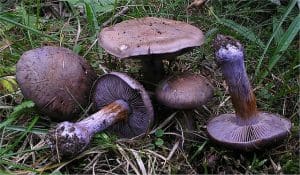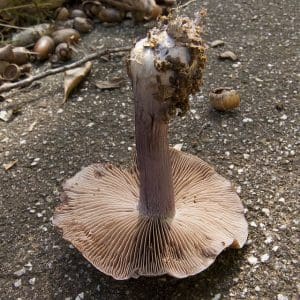Bruising Webcap / Summer / Autumn / Winter / Inedible
The Bruising Webcap (Cortinarius purpurascens) is a captivating and somewhat enigmatic mushroom tha is found primarily in coniferous and mixed woodlands across Europe and North America, this mushroom is distinguished by its striking colour changes upon handling.
The Bruising Webcap features a convex to flat cap that ranges in colour from purple to reddish-brown, with a fibrous texture that can appear silky or slightly sticky when wet. Its gills are initially a pale violet, transitioning to rusty brown as the spores mature, while the sturdy stem often showcases similar hues, adorned with remnants of the web-like cortina.
What sets the Bruising Webcap apart is its dramatic bruising reaction; when the flesh is damaged or cut, it rapidly turns reddish-purple, providing a key identification feature.
In this blog post, we’ll delve into the distinctive characteristics of the Bruising Webcap, offering tips on how to accurately identify this fascinating fungus in its natural habitat.
Scientific Name
Cortinarius purpurascens
Common Names
Bruising Webcap
Family
Cortinariaceae
Habitat
They are ectomycorrhizal and can be found in broadleaf and mixed woodlands particularly around Oaks and Beech.
Description
An uncommon species in Britain and Ireland, the Bruising Webcap is one several purplish webcaps that are difficult to separate on macroscopic characters.
Identifying Features:
Cap:
The cap is 3–10 cm in diameter, convex when young before flattening out with age. The margin is rolled inward. The caps are lilac to purple when young becoming more brown with age. The margin is fibrillose (covered with roughly parallel threadlike filaments).
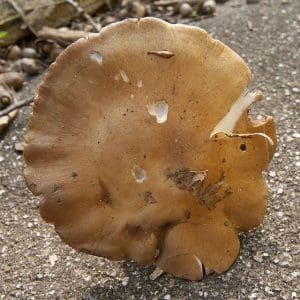
Stem:
The stem has a swollen base and is lilac to purple in colour. When older the stem usually has an orange band around it caused by the spores sticking to what is left of the cortina where it was joined to the stem.
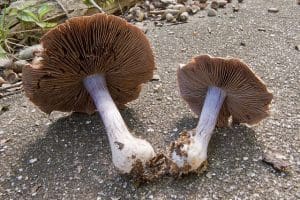
Gills:
When young the gills are covered by a spider web like structure called a cortina which soon breaks up and is usually absent on older mushrooms. The gills are fairly thick and quite widely spaced and start lilac/purple turning to orange/brown when the spores mature. The gill attachment is adnate or broadly emarginate.
Like the rest of this fungi, the gills turn purple if they are bruised.
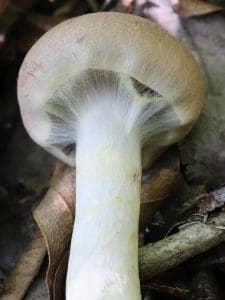
Smell:
No distinct smell.
Spores:
Brown.
Known hazards
Although it has been recorded as edible, this mushroom and other webcaps are best avoided as many contain dangerous toxins for example orellanine, which if eaten destroys human kidneys and liver.
Potential lookalikes
They could possibly be confused with a Wood Blewit (Lepista Nuda) but these lack the cortina or orange band on the stem and Blewits have a lilac spore print.
- Cortinarius violaceus (Violet Webcap)
- Appearance: Deep violet cap, stem, and gills.
- Key Differences: The Violet Webcap is more uniformly violet throughout its entire structure, including the gills, and does not exhibit the distinctive bruising reaction of the Bruising Webcap. Additionally, it tends to have a more velvety texture compared to the often silky or slightly sticky cap of the Bruising Webcap.
- Cortinarius alboviolaceus (Pearly Webcap)
- Appearance: Pale lilac to greyish cap, with a fibrillose surface.
- Key Differences: The Pearly Webcap has a paler, more pearlescent appearance and lacks the intense purple tones of the Bruising Webcap. It also does not bruise reddish-purple when handled.
- Cortinarius purpurascens var. largus
- Appearance: Similar to Cortinarius purpurascens but larger in size.
- Key Differences: The larger variety is very similar to the Bruising Webcap in appearance but can be differentiated by its typically larger size and more robust stature. The bruising reaction is similar, so size and habitat may be the distinguishing factors.
- Cortinarius iodes (Violet Cort)
- Appearance: Sticky, violet cap with paler gills that turn rusty brown.
- Key Differences: While the Violet Cort has a sticky violet cap, it usually has more vibrant, glossy coloration and does not exhibit the same bruising reaction. The gills also change to a rusty brown color more rapidly than those of the Bruising Webcap.
- Cortinarius traganus (Gassy Webcap)
- Appearance: Purple to violet cap and stem with a strong, unpleasant odor.
- Key Differences: The Gassy Webcap can be distinguished by its notably unpleasant smell and the lack of a bruising reaction. Its coloration can be similar, but the odor and non-bruising characteristic are key differentiators.
Extra Notes
The scientific name Cortinarius means curtain and is a reference to the partial veil or cortina that covers the gills when caps are immature. As you might expect, purpurascens indicates that the flesh of this mushroom turns purple when bruised.
References:
https://www.first-nature.com/fungi/cortinarius-purpurascens.php



